
Poojya Gurudev! How do we describe someone in words who is as vast as the cosmos itself, who is one with the Brahman, who is our Parmeshwar. O Karunavatar! Please bless us so that we can attempt to articulate your magnanimity, your grace, your greatness in a few humble words.
Childhood and early life
Born in the village of Baroj in Purva Midnapur district of West Bengal, Poojya Gurudev's name in his growing up days was Sudhanshu Shekhar. Since childhood, he was inwardly focussed and had an immense sense of compassion for the underprivileged.
The fact that he was blessed with the darshan of the divine Maa in his childhood is just one of the many indications of his spiritual greatness. Once he was running high fever and around midnight, an energy inspired him to run towards the Devi temple near his house and on reaching there, the Jagat-Janani Maa herself appeared before him in a holy white attire. He ran back home and fainted as he reached back. Maa took away his fever and blessed him with an immovable sense of devotion, reverence and faith towards her.
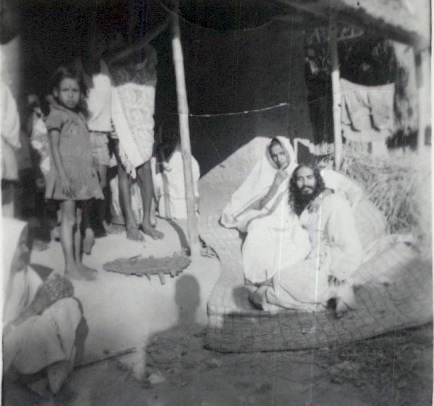
As he grew up, he was inspired by the autobiographies of Shree Ramakrishna Paramhansa Dev and Shree Chaitanya Mahaprabhu. Even though he involved himself in activities apt for the age including studies, sports, NCC, fishing, boating, field work and the rare outings to a restaurant or movie with his college mates, he always had a strong spiritual inclination and modelled himself to be an ideal human being. He even self taught himself various Yog Asanas by reading various books. In the absence of any Guru back then, he would often recite himself to sleep with the sound of 'Om'.
Like Lord Shree Ram, his life shows us the way to how to be involved yet detached from worldly surroundings.
Meeting with his Guru and his spiritual journey
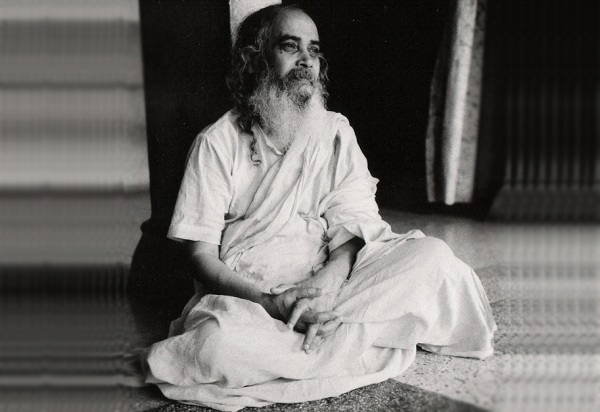
In his childhood, Poojya Gurudev would often see a dream where he was being chased by dark clouds and boulders and he would try to run away till he would reach a saint sitting in a cottage and fall in his lap. The saint would pick him up, dust him and introduce him as Gadadhar from the times of Shree Chaitanya Mahaprabhu.
After completing his graduation in Maths, Poojya Gurudev started working as a teacher and switched different schools till he enrolled in a school in Bhadrakali village and upon reaching there, he found the exact same cottage he had seen in his dreams. There he also saw the photo of the saint who had appeared in his dreams and found out that it was Shree Shree Hariharanand Pahari Baba who later on became his Guru.
In a ceremony where the great Guru lineage of Mahavatar Shree Babaji Maharaj, Poojya Shree Lahari Mahasaya and Poojya Shree Satyanand Giri were invoked, Shree Pahari Baba initiated him with Mantra Deeksha, Kriya Yog Deeksha and Manas Sanyas Deeksha. Shree Shree Pahari Baba also bestowed him with the name Bhubaneswaranand. With it, he renounced all worldly ties at a young age though he remained resolute to serve and perform necessary duties towards his parents. It's unimaginably painful to cut ties with the very family that you love and who brought you up with so much care and affection but such are the sacrifices needed in pursuit of Divinity and our Poojya Gurudev was unfaltering on this path.
Poojya Gurudev's devotion towards his Guru is a living lesson for all of us. Though Shree Pahari Baba had a deep compassion and respect towards our Poojya Gurudev and always referred to him as 'Brahmachari Ji', he also subjected him through various stern tests to check his patience and spiritual progress. Poojya Gurudev stood through all the extremities with utmost calm and reverence and devoted his entire energy to Guru and Ashram Sewa. From cleaning the Ashram to writing replies to letters on behalf of his Guru to making Bhog Prasadi to cleaning utensils of the various visitors of the Ashram, Poojya Gurudev did it all while practising the spiritual Sadhanas in the remaining time left.
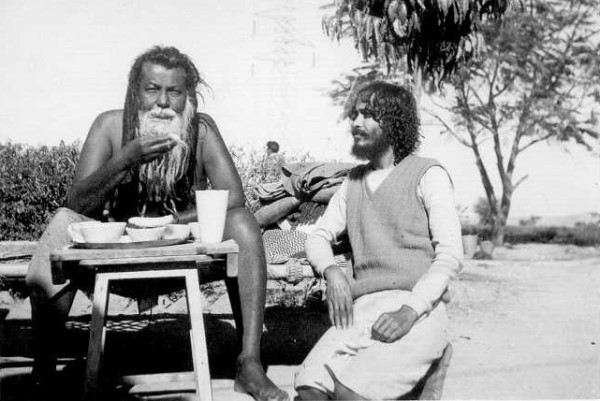
It is through such strict practices and unwavering faith that he gained such spiritual heights so much so that even the Chiranjeevi Shree Mahavatar Babaji Maharaj along with Poojya Shree Lahiri Mahasaya visited him in the Ashram, accepted Bhog Prasadi and guided him at length on the topic of Kriya Yog.
O Lord Gurudev! We are blessed to have come under your refuge, we bow down in front of you a million times.
The Master
मौनादपि मुक्तिदाता, शिष्यास्तु शून्यसंशयाः।।
तस्मै श्री गुरवे नमः। तस्मै श्री गुरवे नमः।।
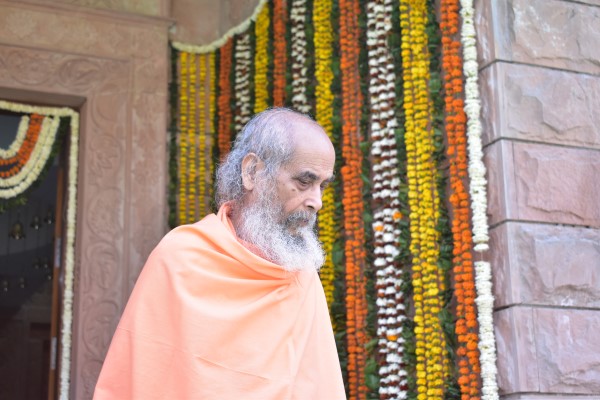
Though it's unfathomable to express his spiritual prowess in words, these lines are one of the many ways to describe Param Poojya Gurudev.
Thou, who in spite of being embodied and in the physical realm, is always focussed on the Shoonya or the nothingness beyond the physical. Thou, who is beyond the worldly emotions, who has gone beyond the qualities of good or bad and become distinctionless from Supreme Brahman. Thou, who without speaking a word, frees his devotees from doubts and leads them to the state of shoonya (अहंकार शून्य एवं विचार शून्य). Hey Poojya Gurudev, we bow down in front of you.
Shree Shree Pahari Baba had mentioned about Poojya Gurudev that “Self realisation is guaranteed” and after the age of 53, he would reach unparalleled heights of enlightenment. Though the meaning of the word 'Brahmachari' with which he referred to Poojya Gurudev means abstinence, it's just one aspect. It also means someone who is walking or is in unison with the ultimate Brahman. Poojya Gurudev is a master of all forms of Yog, including Raj Yog, Bhakti Yog, Tantra Yog and Kriya Yog, yet such is his simplicity and humility that he never reveals himself fully to the world. Shree Bhagvad Gita mentions that pride and ego are characteristics of the ungodly and our Poojya Gurudev shows us a live example of how to be free from them.
Poojya Gurudev showers his guidance and blessings on those who come to him. Depending on the qualities and inclination of the devotee, not just in this lifetime but across different lifetimes, Poojya Gurudev guides them on the path of Bhakti Marg and/or Kriya Marg.
Shree Shree Pahari Baba had unified the two streams of Bhakti Yog and Kriya Yog into one. While Bhakti Yog leads to Purity of Self (Or Atman), Kriya Yog leads to Tranquility of Self (Or Atman). Tranquil state of mind is achieved by physical fitness followed by mental stability, so Kriya Yog has two interrelated parts, some energising exercises along with control of breath by pranayam.
Without Bhakti or devotion and faith, it's impossible to progress on the path of Kriya and without the tranquility of self, one can't focus on Bhakti. Thus the two are interdependent.
Poojya Gurudev has carried forward that lineage and created an environment in the Ashram that helps in the spiritual progress of everyone whether they are devoted to their Guru or to Lord Shiva or to the Goddess Maa. His teachings and blessings have a single goal, to take us to a stage where at the time of leaving this body, we only remember the divine and leave behind all the bondages (karmas) and attain Moksha.

In the holy words of Poojya Gurudev, the two main goals of his lifetime were to establish the Dwadash Jyotirlinga and Shree Guru Narayan Sewa . While the former offers a chance to the devotees to absolve themselves of the material ties and immerse themselves in the worship of Lord Shiva, the latter offers a unique platform to serve the Daridra (the underprivileged) in the form of Narayan. Swami Vivekanand in his famous book on Karma Yog had described how one should feel grateful while serving others instead of expecting gratefulness in return, for they provided you the opportunity to perform this duty. Shree Guru Narayan Sewa trust is following this philosophy.
In other words, the master with selfless compassion blesses and guides us through different routes of Bhakti, Kriya or Karma Yog to attain the ultimate goal. The question remains are we willing enough to listen! He himself is an embodiment of the lessons of Shreemadbhagavad Gita and just by observing him and imbibing even a fraction of his qualities, we can take giant strides on our spiritual journey. The question remains are we willing enough to learn! The master is pouring the knowledge to one and all, the question is do we have our vessels empty enough to receive!
Hey Poojya Gurudev! Please pardon any shortcomings in our words, actions or intentions. The good, bad and the ugly, we surrender all to you.
॥ गुरुर्ब्रह्मा गुरुर्विष्णुः गुरुर्देवो महेश्वरः । गुरः साक्षात् परं ब्रह्म, तस्मै श्रीगुरवे नमः ॥
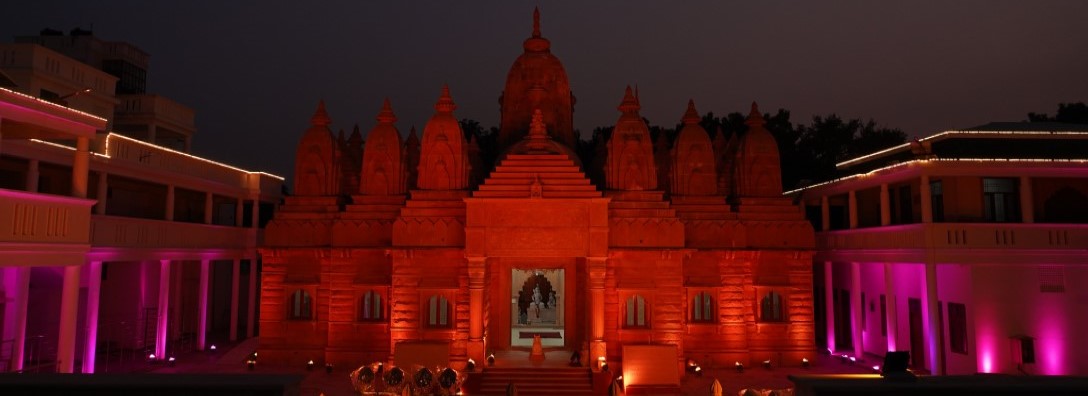
Param Poojya Shree Shree Manavatar Hariharanand Pahari Baba, please bless us mere mortals and guide us in our humble attempt to share a small insight about your divine play (leela), your unceasing benevolence, your countless blessings, your invaluable guidance and your infinite divine splendour (Tejas).
प्रचण्डं प्रकष्टं प्रगल्भं परेशं, अखण्डं अजं भानु कोटि प्रकाशम् ।
त्रयशूल निर्मूलनं शूल पाणिं, भजेऽहं भवानीपतिं भाव गम्यम् ॥
It is almost impossible to describe the magnanimity and divinity of Param Poojya Pahari Baba in words but the above mentioned lines closely describe his attributes.
With a towering persona, long locks of hair, a large beard, presiding over his aasan of Mrig-charm (deer skin), one could see shades of Lord Shiva in his personality. Like Lord Shiva, he could be extremely fierce when required, especially when his devotees needed to be protected. But with an extremely benevolent heart, he would always help his devotees in alleviating their worldly sorrows and sometimes even taking upon himself, their Prarabdha (Karma).

The light of his spiritual prowess shone like a million suns and people from all walks of life,
from near and afar were drawn towards it. He was a master of all forms of Yog. He had received
Tantra Deeksha from the great saint and Tantra Sadhak Shree Tarakhepa Ji and
his Kriya Yog Deeksha from his great Guru Param Poojya Shree Satyanand Ji,
after whose holy name is the Ashram named.
O Rudraswaroop Poojya Pahari Baba! We bow down in humility in front of you, please grant
us refuge under your holy feet.
His primary teachings to his followers was to show love and compassion to their fellow human beings and he would say that “मनुष्य भगवान से भी बड़ा है”. In his effort to help humanity, he established a number of Ashrams across the country and would always open a school and dispensary along with it. He also did a lot of work for uplifting the Adivasi community. Such was his aura, that he turned a lot of fearsome dacoits into his strongest devotees.
Establishment of Shree Satyayatan Pahari Baba Ashram, Jaipur
A Guru can bring about powerful transformations, not only to people but to places too.
An old dilapidated building in the then outskirts of Jaipur popularly known as 'Bhoot Bangla' started its transformational journey of turning into a powerful spiritual centre, a shrine, a Shaktipeeth in the month of April 1974 when Shree Shree Hariharanand Pahari Baba blessed it as the location for his next Ashram, known as Shree Satyayatan Pahari Baba Ashram.
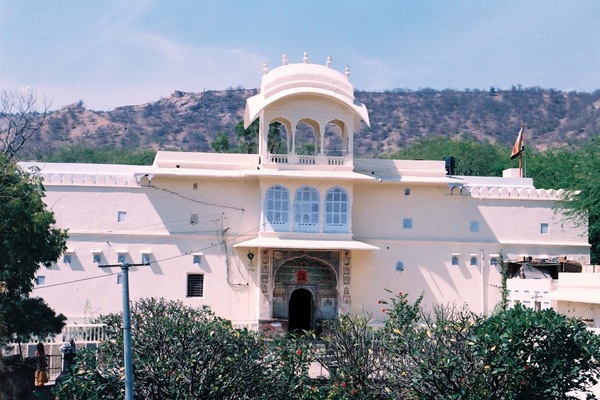
After moving to Jaipur from Barharwa (Bihar) and spending some time at the residence of one of his devotees, on 25th April 1974, the holy footsteps of Shree Shree Pahari Baba entered the Ashram premises.
A week prior to that, our Poojya Gurudev (Shree Bhubaneshwaranand Ji) and Shree Pranatmanand Ji had arrived at the premises and cleaned up the place that was deserted for a long time. They had to clear up the wild growth of plants and drive away the bats residing in the rooms. During the initial days, there was no electricity and oil lamps had to be used.
Surrounded by the Jal Mahal lake, forts of Nahargarh and Jaigarh and famous temples of Garh-Ganesh, Charan Mandir and Amer Temple, Kala Mahadev, the location of the Ashram was the perfect amalgamation of nature and spirituality, a fact that was true even inside the Ashram. With the blessings of the spiritual masters inhabiting it, the Ashram underwent a dramatic change. The wild weeds gave way to numerous beautiful trees and flowering plants, different types of animals and birds also started flourishing, thus creating a delectable environment.
Gradually, a large number of devotees including senior doctors, I.A.S officers and politicians started frequenting the Ashram and received blessings from Shree Shree Pahari Baba. Shree Pahari Baba had unified the two streams of Bhakti Yog and Kriya Yog into one and initiated a lot of devotees with Mantra Deeksha and a selected few in Kriya Yog Deeksha. Shree Pahari Baba's darbar would always be open for his devotees for listening to their problems or engaging in long conversations on topics ranging from spirituality to politics, sometimes late into the night. He was also an expert at homoeopathy, palmistry & viewing horoscope and would often help his devotees with it.
Shree Pahari Baba, out of his deep compassion for the underprivileged, would always start a school and dispensary near his Ashrams and he continued that tradition in the Jaipur Ashram.
The school, which started with a handful of children being taught in the Verandahs of the Ashram, later grew to a strength of more than 350 students at one point of time. After Shree Pahari Baba left for the heavenly abode in 1976, Param Poojya Gurudev continued his lineage and further developed the Ashram. The Ashram became the haven for spiritual seekers as well as people seeking solace from worldly troubles.

After more than 3 decades, Poojya Gurudev decided to set up a new Ashram on a sacred piece of land in Goner and in the year 2020, after spending close to 36 years at the earlier ashram, Poojya Gurudev blessed the Goner Ashram as his place of residence.
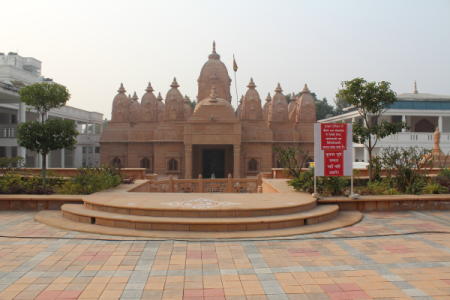
The Shree Satyayatan Pahari Baba Ashram Goner, blessed by the same energy as the earlier Ashram, continues to be a place for devotees to witness the traditions started by Shree Shree Pahari Baba.
Goner Ashram is home to the Maha Shaktipeeth Dwadash Jyotirlingam temple, where one can be blessed with the divine Darshan of all 12 Jyotirling, for each of which Pran-Pratishta was done by Param Poojya Gurudev himself. The grandeur of the temple and the vibrations one can feel upon entering it, has made it a popular pilgrimage drawing large volumes of devotees from nearby areas.
Devotees entering the Goner Ashram can lose themselves in the devotion of Lord Shiv in the Dwadash Jyotirlingam temple, seek shelter at the feet of the jagat-janani Maa in the Matri Mandir, experience the ultimate serenity surrounded by the natural splendour of Panchvati Tapovanam and be reminded of the famous Dakshineshwar temple, be part of the unique initiative of Shree Guru Narayan Sewa and above all, find refuge in the feet of the master who has created this all, our Poojya Gurudev.
For those who come with devotion and faith, this is the only Teerth (Pilgrimage) they ever need!
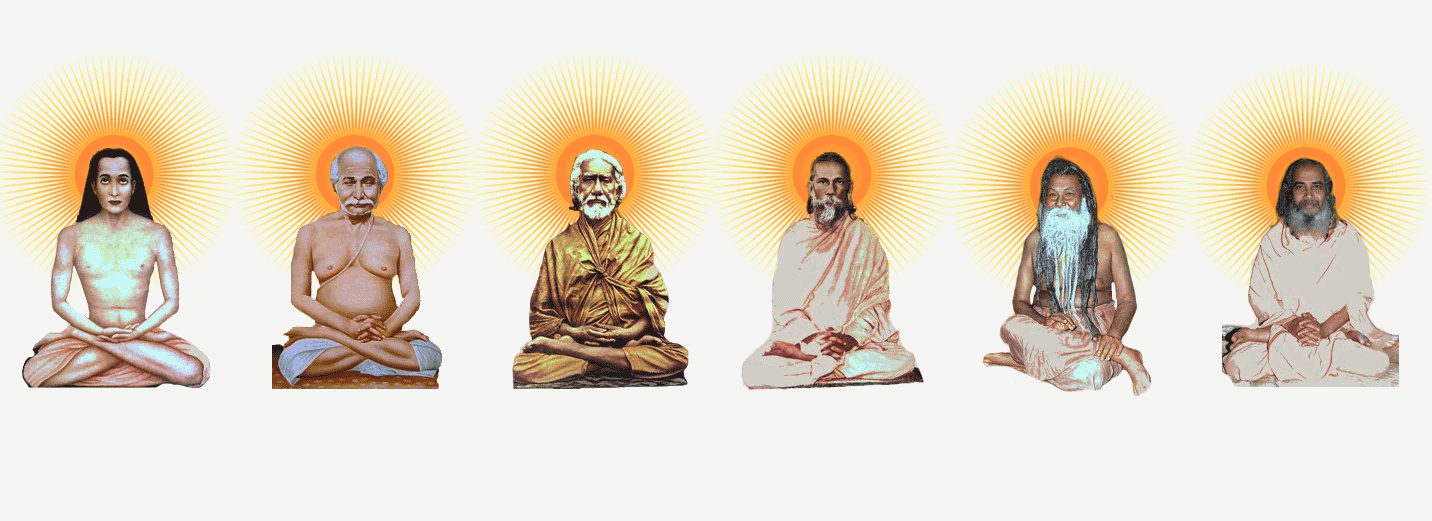
Kriya Yog is made up of two words Kriya and Yog. Kriya means action and in this context, it means the action of breathing and Kriya Yog involves various techniques to control one's breathing. The other word is Yog which literally means union and as beautifully explained by Poojya Gurudev, it means union with the divine. Without unfaltering faith and devotion in the divine, it's not possible to advance on this path, thus emphasizing the interdependence between Kriya Yog and Bhakti Yog.
Yog here also refers to a set of physical exercises or Mudras that are practiced as part of Kriya Yog, namely Mahamudra, Khechri Mudra and Yoni Mudra. These Mudras in association with Pranayam techniques help bring about transformations at different dimensions from the outermost to the innermost.
On one hand it increases the physical fitness which is a basic essentiality for practicing Kriya Yog and on deeper levels, it helps bring stability of breath that leads to a stability of mind which then helps in achieving higher levels of concentration while doing Japa Yog, thus creating a perfect unison between Kriya and Bhakti Yog.
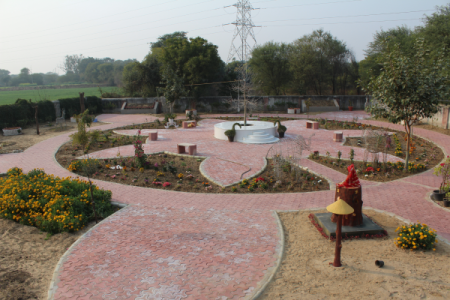
In other words, while Bhakti Yog leads to Purity of Self (Or Atman), Kriya Yog leads to Tranquility of Self (Or Atman). Tranquil state of mind is achieved by physical fitness followed by mental stability, so Kriya Yog has two interrelated parts, some energising exercises along with control of breath by pranayam. Without Bhakti or devotion and faith, it's impossible to progress on the path of Kriya and without the tranquility of self, one can't focus on Bhakti.
Our psychological condition is affected by our breathing. When we are glad or tensed, the breathing pattern is in a certain way. Kriya Yog helps us attain power over our breathing procedure, thus controlling our psychological state. It's not possible to realise the kingdom of God that's within us without breaking the attachment with physicality. Kriya Yog helps in achieving that. By controlling our breathing and channelizing our energies, we magnetise our spine that in turn further draws tremendous amounts of the vital life force and takes our energies beyond that of the physical. With regular practice of Kriya, every cell of the body changes, vibrates differently and becomes one with the Cosmic Energy.
Kriya Yog helps in opening the energy Chakras, starting by strengthening the 'Root Chakra' which is the base of all Chakras and ultimately leads to the rise of Kundalini energy. Each of the Chakras impact our physical, mental, emotional and spiritual wellbeing and a Kriya practitioner with the blessings and guidance of their Guru would start to feel transformations in all these aspects whether it's their physical wellbeing, mental or emotional harmony, the ability to immune themselves from the outer surroundings, turn their focus from the external to the internal and in advanced stages, reach the state of perennial bliss also called as Samadhi.
Origin of Kriya Yog
Long ago, there was a great saint in the southern parts of India who is reverentially called as Mahavatar Shree Babaji Maharaj. Poojya Shree Shyamacharan Lahiri, was a great saint of Bengal and a householder (grahastha) Guru who showed the way to grow on the path of spirituality while managing social responsibilities.
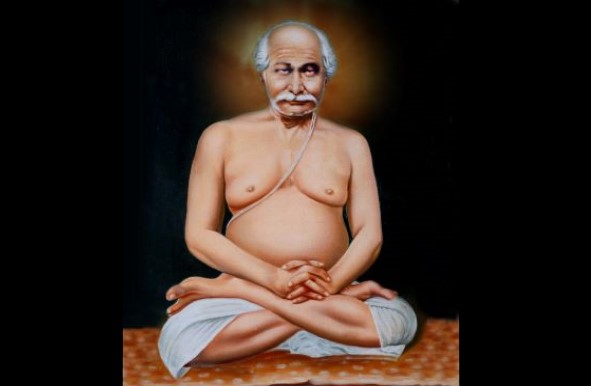
In the year 1861, while working as an accountant in the Military Engineering Dept, Shree Lahiri Mahsaya was transferred to Ranikhet. One day while walking through the nearby Dunagiri hills, he was surprised to hear a distant voice calling his name. On following the voice, he met Mahavatar Shree Babaji Maharaj who initiated him with a set of practices or Sadhanas that is known as Kriya Yog. Mahavatar Shree Babaji Maharaj mentioned to him that he was chosen to be an example of an ideal Yogi-householder to the world and show that the highest Yogic attainments are not barred to a family person and that outer renunciations are not necessary to achieve the same.
Shree Lahiri Mahasaya requested Shree Babaji Maharaj for permission to communicate Kriya to all seekers, even though at first they cannot vow themselves to complete inner renunciation; which Mahavatar Babaji Maharaj agreed with. Shree Lahiri Mahasaya spread Kriya Yog to all those who humbly seeked it without discriminating on caste or religion.
Later on the disciples of Shree Lahiri Mahasaya, namely Shree Yukteshwar Giri Ji, Shree Yoganand Ji and Shree Satyananda Giri Ji continued the legacy and played a big role in spreading this knowledge to different parts of the country & abroad. Shree Yoganand Ji started his teachings from Ranchi and later on established the Self Realization Fellowship and helped spread this knowledge in the western countries. As some of the practices were physically challenging for the people of the west, he modified some techniques and added some energizing exercises to enable them physically to follow this path.
